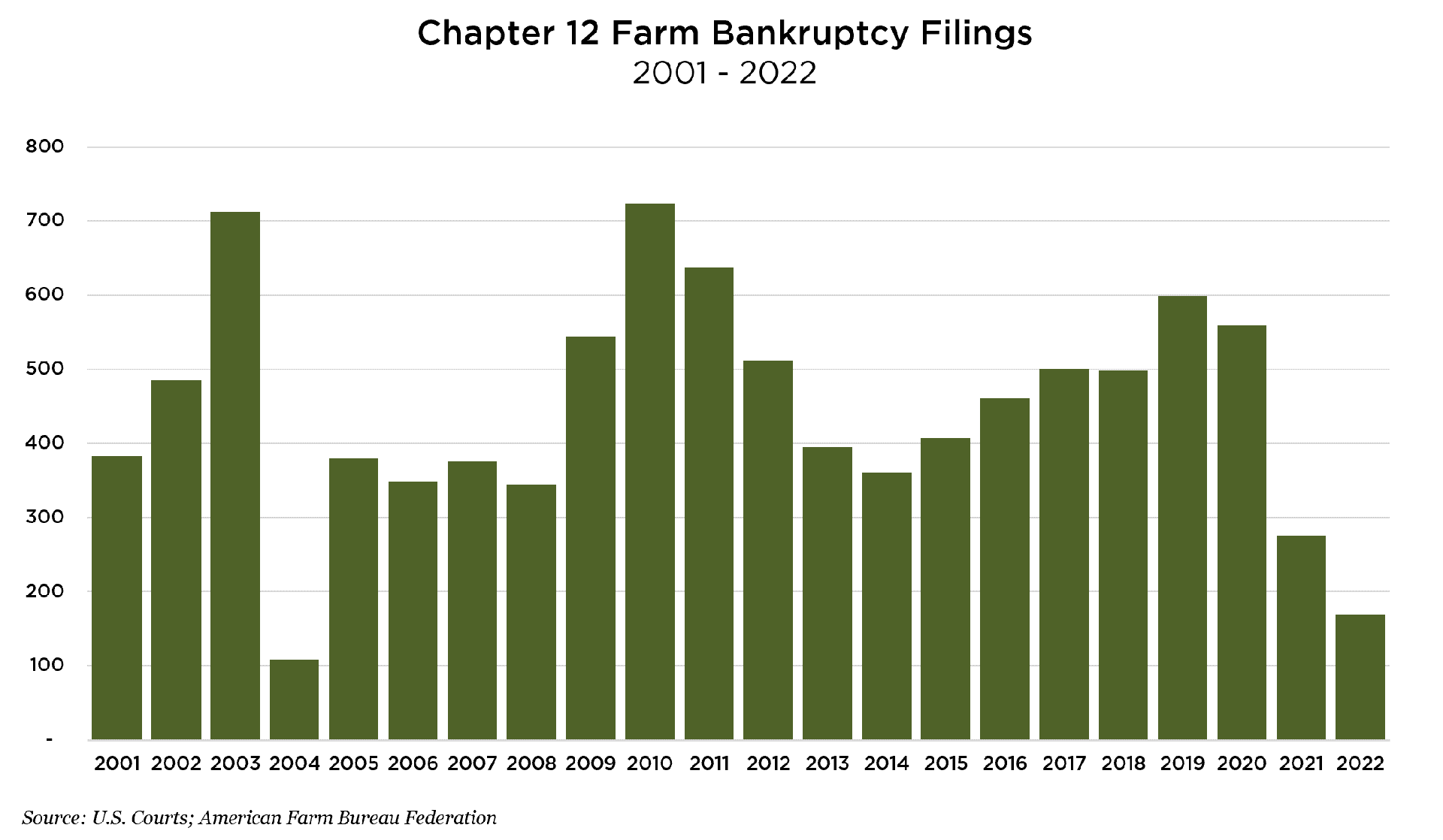Farms see fewer bankruptcy filings as incomes soar
Farm bankruptcy filings fall for third straight year
According to data from the U.S. Courts, Chapter 12 farm bankruptcy filings fell in 2022 to the lowest level since 2004, underscoring the health of farm balance sheets discussed in this space recently.

Despite the significant decrease in filings, only four of eight regions saw fewer filings in 2022 than in 2021. Those regions were: the Midwest, the Southeast, the Southwest, and the Northeast. In part a function of the number of farms in these regions, the Midwest and Southeast led all regions in bankruptcy filings.
Increases in filings were seen in the Mid-Atlantic, West, and Northwest regions, as well as the region categorized as “Other,” which includes states and territories not in the Contiguous United States (i.e., Alaska, Hawaii, Washington, D.C., Puerto Rico, Guam, the U.S. Virgin Islands).
Filings were down in 24 states or territories and unchanged in 19. Only 11 states or territories saw an increase in filings. The largest decline was seen in the Midwest, which went from 144 filings in 2021 to 47 in 2022. Additionally, New York led all states and territories in filings with 16; it was the first year since 2015 that Wisconsin was not the leader in filings.
The recent downward trend in filings has been sharp. Filings nationwide were cut in half from 2020 to 2021 before falling another 40 percent in 2022. In total, filings are down over 70 percent since 2019. The low number of filings corresponds with very strong net farm incomes due to high ag commodity prices which have more than offset rising input costs for farms. Areas with significant reductions in filings grew high-priced crops (e.g., corn and soybeans are grown primarily in the Midwest), while poor weather resulted in an increase in filings elsewhere (e.g., intense drought conditions in the West, particularly California).
It should be noted that the most recent Farm Sector Income Forecast from the USDA calls for a decrease in net farm income this year while expenses are expected to climb further. In combination, these trends could result in an uptick in bankruptcy filings for 2023.
Ag News Highlights
Higher corn and soybean acreage expected
According to the 2023 USDA Prospective Plantings report, producers intend to plant 92.0 million acres of corn this year, which is more than one million acres higher than prior estimates and 3.4 million acres more than in 2022. If the estimates from the survey are accurate, this year’s corn production in Arizona and Idaho will be the largest on record and 40 of 48 corn producing states will see their corn production rise or be unchanged from 2022. Soybean growers are projected to plant 87.5 million acres, up slightly from last year and including record acreage in Illinois, Nebraska, New York, Ohio, and Wisconsin.
Also included in the report were acreage estimates for wheat and cotton, which are expected to be up nine and 18 percent, respectively.
Meat exports a boost to grains prices
Cattle and hog feed account for a sizable portion of the global demand for corn and soybeans. A new economic impact study done by World Perspectives, Inc. details exactly how much of the market for both grains can be attributed to meat exports. The study, which was released by the U.S. Meat Export Federation (USMEF) concludes that beef and pork exports contributed an estimated total economic impact of 15 percent to the value of corn and 13 percent to the value of soybeans in 2022. Using prices from the 2022 marketing year, this works out to $1 per bushel of corn and $1.94 per bushel of soybeans. In total, this equates to an added value of over $5 billion to the corn and soybean market via beef and pork exports last year.
New H-2A wage rule could add to labor costs
Analysis from the American Farm Bureau Federation (AFBF) suggests that the Adverse Effect Wage Rate (AEWR) Methodology for the Temporary Employment of H-2A Nonimmigrants in Non-Range Occupations recently created by the U.S. Department of Labor could have a substantial impact on labor costs for all farms, but especially for small farms. Details of the final rule, which went into effect March 30, are included in the analysis found on the AFBF website, which concludes that the average small farm will see a 12.6 percent increase in wage outlays this year (large firms are estimated to see a 5.5 percent increase). If consultations do not yield a remedy, a panel will be established to examine evidence and hear oral testimony from both sides, then render a verdict on which party is in violation of the USMCA. USDA secretary Tom Vilsack is confident in a positive outcome for the U.S., saying, “We remain firm in our view that Mexico’s current biotechnology trajectory is not grounded in science, which is the foundation of the USMCA.”
Citations/Disclaimers
-
The information in this report is provided by Nationwide Economics and is general in nature and not intended as investment or economic advice, or a recommendation to buy or sell any security or adopt any investment strategy. Additionally, it does not take into account any specific investment objectives, tax and financial condition or particular needs of any specific person.
The economic and market forecasts reflect our opinion as of the date of this report and are subject to change without notice. These forecasts show a broad range of possible outcomes. Because they are subject to high levels of uncertainty, they will not reflect actual performance. We obtained certain information from sources deemed reliable, but we do not guarantee its accuracy, completeness or fairness.

